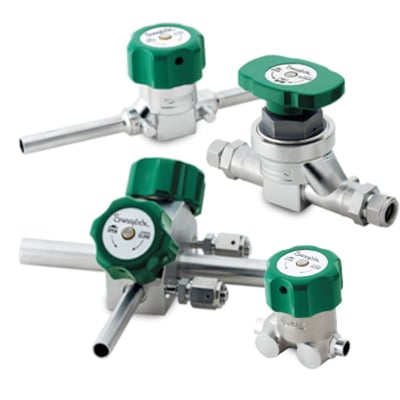Share this
Choosing a Pressure Control Valve for Oil and Gas Applications
by Morgan Zealear on 10/22/21 9:00 AM

Pressure control valves play an essential role in refinery operations. If properly set up and integrated, the control valves will allow for the correct amount of different substances—in gaseous or liquid phases—for processes. This ultimately results in favorable outputs in terms of quantity and quality in an expedient manner.
When choosing a pressure control valve for oil and gas applications, it’s important to ensure that the valve can integrate seamlessly into your operations and safely transport the chemicals. This is especially true because the body of a control valve varies based on size and functional constraints. It’s also important to choose an actuator based on the amount of automation and method utilized for altering flow rate. Finally, control valves need to be constructed out of materials that are not corroded by the substances they encounter.
In this article, we will discuss options for the control valve body and its actuator to help you choose an appropriate pressure control valve for your oil and gas applications.
Understanding the Variations in Control Valve Body Elements
The control valve body can differ in material, size, motion, and design. The material used to construct the control valve body should be determined based on the properties of the chemical substances in operations. The overall size of the control valve will be determined by the piping and the ancillary equipment in processing. Valves generally use linear motion or rotation to adjust the working distance between two surfaces, the orifice, and the stem. Depending on how that is accomplished, the body can come in various shapes.
Control Valve Body Designs Options
There are three types of control valves based on body design: double block and bleed valves, manifold valves, and ball valves. These designs each have benefits for specific systems of operations as discussed below.
Double Block and Bleed Valves
Double block and bleed valves allow for primary isolation of substances. They can be designed to be small if space is limited. Double block and bleed valves are frequently used when an absolute shut-off is needed.
Manifold Valves
Manifold valves are often used within a larger system to isolate and control the flow of substances. They are frequently used to control the movement of substances between pumps and actuators. These valves are used to regulate flow in multiple directions (e.g. five-way valves if needed). They can be designed to be small to fit in systems with limited space.
Ball Valves
Ball valves provide a long service life (15+ years depending on the material used in construction). They can be designed to withstand high pressure and are frequently used for shutoff applications.
Once you’ve selected a pressure control valve body for your specific operation, you’ll want to select a compatible actuator.
Selecting the Control Valve Actuator
The control valve actuator is the device connected to the valve through the valve stem that provides the force required to move the valve. It opens and closes the valves based on different system conditions. These include changes in pressure, temperature, and flow. As such, they maintain substances at acceptable conditions for efficient operations. The design options for a control valve operator include the method of control such as controlling them electrically, pneumatically, or hydraulically. Choosing between these options is dependent on the chemical substance, the phase of matter of the substance, and if an electronic sensor is being used in conjunction with the valve.
The Benefits of a Fully Integrated and Optimized Control Valve
As control valves regulate the pressure and flow for different substances in operation, control valve failure can be very consequential:
- the correct amount of needed chemicals may not arrive at the specified location
- damage could occur to several systems
- leaks could occur due to a build-up of pressure
- overall operations could be delayed
When selecting control valves for safe and efficient operations, the application of the valve, the operation design specifications, the amount of pressure and temperature in operations, and the substance used in operations must all be taken into account. Swagelok offers several pressure control valve options to fulfill these needs.
Top-Quality Pressure Control Valves
The following table shows several top-quality options for control valves offered by Swagelok. These options differ based on the type of fuel being processed and options to increase efficiency and safety—such as preventing leaks to the atmosphere based on the pressure, flow, and the need for continuous use.
| Pressure control valve option | Unique characteristics and benefits of valve |
| Diaphragm-sealed Valves |
|
| Ball and Quarter-turn Plug Valves |
|
| Bellows-sealed Valves |
|
| Check Valves |
|
| Manifolds |
|
| Needle and Metering Valves |
|
The control valve body plays an important role in controlling flow and there are several different designs to choose from. The type of processing occurring is important to consider for the materials being used in the valve and the type of control valve being used. If the type of processing is not considered, substances could be incompatible with the control valve and result in increased corrosion. The type of substances used in operation is also important as the pressure threshold varies between different types of control valves. A build-up in pressure could be damaging not only to the control valve but to systems and piping throughout the whole operation. Further, the operating methods employed are important to note for choosing a control valve actuator as differing levels of automation and control may require different actuators.
Expert Guidance on Choosing Pressure Control Valves for Oil and Gas Applications
An expert in control valves and refinery operations can help identify the optimal control valve option for processing based on the intended purpose of processing. Ultimately, the proper choice in a control valve will reduce maintenance costs and mitigate production delays. It is therefore ideal to work with an expert to get a fully optimal control valve based on your operational needs.
Swagelok has the experts to help you make the proper decisions for the implementation of upgrades of control valves. Swagelok’s control valves have a range of options including ball and quarter-turn plug valves, bellows-sealed valves, diaphragm sealed valves, and manifolds. These options will cover all your control valve needs.
For decades, we have helped process and manufacturing companies in Northern California and Western Nevada improve the reliability of critical components within their oil and gas applications. We’ll work closely with you to understand your specific process requirements. With this understanding, we’ll recommend pressure control valves for safe and efficient operations.
To learn more about how Swagelok Northern California can help you with your control valve needs, contact our team today by calling 510-933-6200.
 Morgan Zealear | Product Engineer – Assembly Services
Morgan Zealear | Product Engineer – Assembly Services
Morgan holds a B.S. in Mechanical Engineering from the University of California at Santa Barbara. He is certified in Section IX, Grab Sample Panel Configuration, and Mechanical Efficiency Program Specification (API 682). He is also well-versed in B31.3 Process Piping Code. Before joining Swagelok Northern California, he was a Manufacturing Engineer at Sierra Instruments, primarily focused on capillary thermal meters for the semiconductor industry (ASML).
Share this
- Archive (465)
- Assembly Services (207)
- About (100)
- Seal Support Systems (96)
- Best Practices (88)
- Training Services (74)
- Fittings (51)
- Semiconductor Applications (49)
- Hoses and Flexible Tubing (47)
- Regulators (44)
- Tubing (42)
- Grab Sampling Systems (32)
- Sampling Systems (32)
- Gas Systems (30)
- Services (30)
- Downloads (29)
- Valves (24)
- Application Support (18)
- Orbital Welding (17)
- Case Studies (13)
- Steam Systems (13)
- Frequently Asked Questions (12)
- Tools (12)
- Measurement Devices (7)
- Subsystems (6)
- Thermal Management (6)
- September 2023 (1)
- August 2023 (2)
- June 2023 (1)
- March 2023 (3)
- February 2023 (3)
- January 2023 (4)
- December 2022 (4)
- November 2022 (4)
- October 2022 (4)
- September 2022 (1)
- August 2022 (3)
- July 2022 (2)
- June 2022 (4)
- May 2022 (1)
- April 2022 (2)
- March 2022 (1)
- February 2022 (2)
- January 2022 (3)
- December 2021 (1)
- November 2021 (6)
- October 2021 (6)
- September 2021 (8)
- August 2021 (4)
- July 2021 (3)
- June 2021 (6)
- May 2021 (6)
- April 2021 (7)
- March 2021 (5)
- February 2021 (4)
- January 2021 (6)
- December 2020 (5)
- November 2020 (6)
- October 2020 (6)
- September 2020 (8)
- August 2020 (7)
- July 2020 (8)
- June 2020 (8)
- May 2020 (6)
- April 2020 (9)
- March 2020 (7)
- February 2020 (10)
- January 2020 (21)
- December 2019 (23)
- November 2019 (21)
- October 2019 (22)
- September 2019 (21)
- August 2019 (22)
- July 2019 (23)
- June 2019 (20)
- May 2019 (23)
- April 2019 (22)
- March 2019 (21)
- February 2019 (20)
- January 2019 (21)
- December 2018 (14)
- November 2018 (19)
- October 2018 (23)
- September 2018 (17)
- August 2018 (29)
- July 2018 (11)
- June 2018 (6)
- May 2018 (5)
- April 2018 (4)
- March 2018 (5)
- February 2018 (3)
- January 2018 (3)
- December 2017 (2)
- November 2017 (4)
- October 2017 (3)
- September 2017 (2)
- August 2017 (6)
- July 2017 (4)
- June 2017 (4)
- May 2017 (4)
- April 2017 (3)
- March 2017 (4)
- February 2017 (3)
- January 2017 (3)
- December 2016 (3)
- November 2016 (3)
- October 2016 (3)
- September 2016 (5)
- August 2016 (5)
- July 2016 (4)
- June 2016 (5)
- May 2016 (3)
- April 2016 (4)
- March 2016 (5)
- February 2016 (11)
- January 2016 (1)
- December 2015 (3)
- November 2015 (4)
- October 2015 (3)
- September 2015 (4)
- August 2015 (4)
- July 2015 (8)
- June 2015 (5)
- May 2015 (3)
- April 2015 (4)
- March 2015 (4)
- February 2015 (3)
- January 2015 (4)
- December 2014 (2)
- November 2014 (3)
- October 2014 (4)
- September 2014 (4)
- August 2014 (4)
- July 2014 (5)
- June 2014 (4)
- May 2014 (4)
- April 2014 (5)
- March 2014 (4)
- February 2014 (3)
- January 2014 (4)
- December 2013 (5)
- November 2013 (3)
- October 2013 (4)
- September 2013 (3)
- August 2013 (5)
- July 2013 (5)
- June 2013 (5)
- May 2013 (3)
- April 2013 (6)
- March 2013 (4)
- February 2013 (4)
- January 2013 (8)
- December 2012 (4)
- November 2012 (6)
- October 2012 (6)
- September 2012 (4)
- August 2012 (4)
- July 2012 (4)
- June 2012 (4)

.webp?width=210&height=70&name=StickyLogo%20(5).webp)